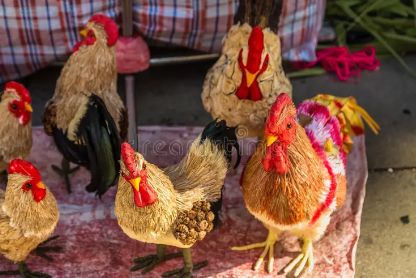The Padova chicken, an iconic breed originating from Italy, is renowned for its unique appearance, vibrant personality, and historical significance. Known for its striking feathered crest and exceptional hardiness, the Padova, also called the Padovana chicken, has become popular among poultry enthusiasts and farmers alike. This article delves into the history, characteristics, and care of the Padova chicken while exploring its benefits, challenges, and applications in both domestic and farming settings. Whether you’re a poultry enthusiast, small-scale farmer, or curious reader, this guide will offer a detailed overview of everything you need to know about this charming breed.
What is the Padova Chicken?
The Padova chicken is a heritage breed originating from Padua, a region in Northern Italy. This breed is known for its regal look, featuring a dense feathered crest that covers much of its head. The Padova chicken falls under the crested chicken category and has a rich history tied to European poultry breeding traditions.
Origin and History of the Padova Chicken
The Padova chicken breed dates back to the Renaissance era when it was developed as an ornamental breed due to its unique feather pattern and striking appearance. Historical records suggest that Padova chickens were selectively bred to be resilient to various climate conditions. The breed’s popularity spread across Europe in the 18th and 19th centuries, where it became appreciated not only for its beauty but also for its adaptability and egg-laying capabilities.
Key Characteristics of the Padova Chicken
- Crested Appearance: The most notable feature of the Padova chicken is its impressive, fluffy crest that often resembles a crown.
- Body Size: Padova chickens are medium-sized, with roosters weighing around 2.5 kg and hens weighing 2 kg on average.
- Color Varieties: This breed comes in various colors, including white, black, gold, and silver.
- Temperament: Generally calm and docile, Padova chickens adapt well to both free-ranging and enclosed environments.
- Egg Production: Though not a high-production breed, hens lay around 120 to 150 eggs annually, making them a viable option for small-scale egg production.
Importance and Benefits of the Padova Chicken Breed
The Padova chicken holds both cultural and practical significance. Its versatility and adaptability make it a valuable addition to homesteads and ornamental flocks.
Cultural and Ornamental Value
The Padova chicken is celebrated in Italian culture as a symbol of beauty and resilience. Its distinct appearance, often compared to other heritage breeds like the Polish chicken, adds visual appeal to any flock.
Adaptability and Resilience
Padova chickens are hardy birds capable of withstanding a range of climates. Their dense feathering provides insulation, making them resilient in cold conditions. Their adaptability contributes to lower maintenance needs and makes them well-suited for various regions.
Benefits for Small-Scale Farming
While not a prolific egg-layer compared to commercial breeds, the Padova chicken’s eggs are medium-sized and have a rich flavor. Additionally, the breed’s calm nature and manageable size make it ideal for small farms, hobbyists, and urban setups.
Applications and Use Cases for the Padova Chicken
Due to its unique qualities, the Padova chicken finds applications in various areas beyond traditional egg and meat production.
Heritage and Ornamental Flocks
The Padova chicken is a top choice for ornamental poultry enthusiasts due to its decorative plumage and heritage status. Exhibitors often showcase this breed at agricultural shows and poultry exhibitions, highlighting its aesthetic appeal.
Family-Friendly Backyard Flocks
Padova chickens are excellent for families and beginners in poultry keeping. Their gentle nature, combined with their moderate egg-laying ability, makes them easy to care for. They are often found in backyard flocks, adding diversity and charm to small-scale setups.
Educational Programs and Conservation Efforts
Organizations focused on poultry conservation frequently use the Padova chicken to educate the public about heritage breeds. Conservation programs also prioritize this breed to maintain genetic diversity and promote sustainable farming practices.
Challenges of Raising Padova Chickens
While Padova chickens offer numerous benefits, there are challenges associated with raising this breed. Understanding these issues and solutions can help owners manage these chickens effectively.
Feather Maintenance
The breed’s striking crest and feathers require extra care to prevent dirt and parasites. Owners should monitor for mites or lice, which can hide in the dense feathering. Regular grooming and dust baths help keep their plumage healthy.
Vulnerability to Predators
Padova chickens, with their limited vision due to the crest, are more vulnerable to predators. Keeping them in secure enclosures or supervised free-range areas can prevent potential attacks.
Seasonal Egg Production
The Padova chicken’s egg-laying may reduce significantly in winter due to shorter daylight hours. Some owners use supplemental lighting in coops to help maintain consistent egg production during these months.
Potential Health Issues
Padova chickens may be prone to respiratory issues in overly humid or dusty environments. Ensuring well-ventilated, dry coops is vital for preventing respiratory ailments. Proper hygiene practices in and around the coop also help in disease prevention.
Best Practices for Caring for Padova Chickens
Raising Padova chickens requires some specific care to maintain their health and appearance.
Housing Requirements
- Space: Provide at least 4 square feet per bird within the coop to allow comfortable movement.
- Ventilation: Ensure proper ventilation in the coop to reduce humidity and ammonia buildup.
- Roosts: Due to their feathered heads, provide roosting spaces at varying heights to prevent overcrowding.
Diet and Nutrition
- Balanced Feed: A balanced poultry feed with adequate protein supports healthy feather growth.
- Calcium and Grit: Provide a calcium supplement for laying hens to strengthen eggshells. Offer grit to aid digestion, particularly if they are foraging outdoors.
- Fresh Greens and Insects: Padova chickens enjoy occasional treats like leafy greens and insects, which add diversity to their diet.
Grooming and Feather Care
Regularly check for parasites and use dust baths to maintain feather health. During wet seasons, dry their crest feathers if they become waterlogged, as prolonged dampness can lead to skin issues.
Managing Cold and Heat Stress
While Padova chickens are relatively cold-hardy, extreme weather can impact their comfort and health. In winter, consider insulated coops and straw bedding for warmth. During summer, ensure they have shaded areas and cool water to prevent overheating.
Selecting and Breeding Padova Chickens
When adding Padova chickens to a flock, sourcing high-quality birds from reputable breeders is essential.
Choosing Quality Birds
Select birds with healthy plumage, clear eyes, and a well-formed crest. Avoid birds with overly thin bodies or signs of feather damage, which can indicate health issues.
Breeding Considerations
Due to their crested heads, Padova chickens have a unique genetic trait for their feathered crest, requiring selective breeding to maintain this characteristic. Breeders should also focus on selecting birds with healthy plumage and robust immunity to ensure sustainable breeding.
Maintaining Breed Standards
For those interested in showcasing Padova chickens, maintaining breed standards is essential. This includes preserving physical characteristics such as crest size, feather color, and body proportions as outlined by poultry associations.
Common Misconceptions about the Padova Chicken
The Padova chicken’s unique appearance often leads to several misconceptions.
Myth: Padova Chickens Are Only Ornamental
While Padova chickens are undeniably beautiful, they are more than just ornamental. They are hardy, versatile birds suited to small farms, backyard coops, and educational settings.
Myth: Padova Chickens Are Difficult to Care For
Though their crests require occasional maintenance, Padova chickens are generally low-maintenance. Their calm nature and adaptability make them ideal for novice poultry keepers.
Myth: Padova Chickens Don’t Lay Eggs
While not prolific layers, Padova hens produce a respectable number of eggs annually. Their eggs, typically cream-colored and medium-sized, are valued for their flavor.
The Padova Chicken in Modern Poultry Farming
The Padova chicken is not only valued by enthusiasts but is also gaining recognition in sustainable poultry farming.
Sustainable Farming Practices
Due to their resilience and relatively low maintenance needs, Padova chickens align well with sustainable farming. Farmers seeking a dual-purpose bird for small egg production and heritage conservation find the Padova chicken a fitting choice.
Adding Genetic Diversity to Flocks
In modern poultry breeding, genetic diversity is crucial. The Padova chicken, with its unique lineage, contributes to genetic health in mixed flocks, especially for backyard or conservation farms.
Showcasing at Agricultural Exhibitions
Agricultural shows often feature Padova chickens due to their unique aesthetics and historical significance. These exhibitions play a role in raising awareness of the breed, encouraging conservation, and promoting its benefits.
Conclusion
The Padova chicken, with its stunning crested plumage and gentle demeanor, brings both charm and functionality to any flock. Ideal for backyard setups, small farms, and poultry exhibitions, the Padova is appreciated for its historical significance and adaptability. While it may require some grooming, its benefits far outweigh these minor demands. As a breed that balances beauty with practicality, the Padova chicken remains a valuable addition to sustainable and ornamental poultry practices. For more info visit Techno Buzz.
FAQs
1. Are Padova chickens good for egg production?
- Padova chickens are moderate layers, producing around 120 to 150 eggs per year. Though not prolific, their eggs are flavorful.
2. Do Padova chickens require special grooming?
- Padova chickens benefit from occasional grooming due to their crests, which can harbor mites or become dirty.
3. Are Padova chickens suitable for beginners?
- Yes, their calm nature and resilience make them well-suited for novice poultry keepers and families.
4. What climates are ideal for Padova chickens?
- Padova chickens are adaptable to various climates but thrive best in moderate weather with a well-ventilated coop.
5. Can Padova chickens free-range safely?
- While they enjoy free-ranging, they need supervision as their limited vision makes them more vulnerable to predators.

